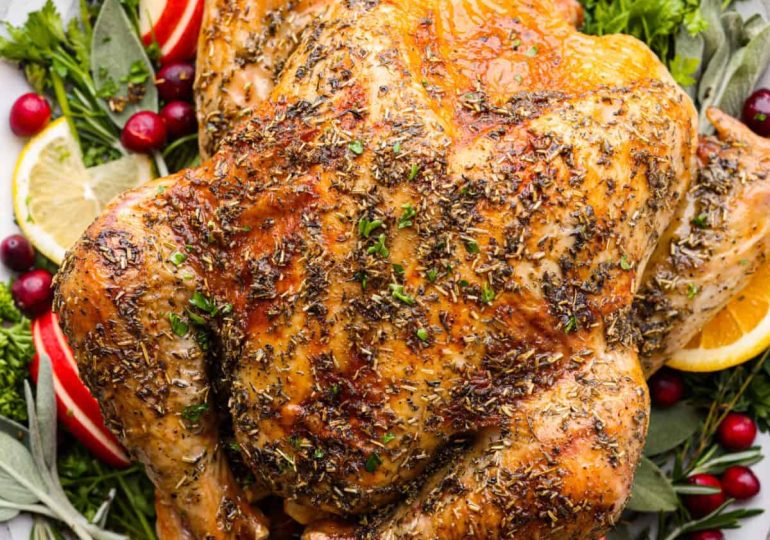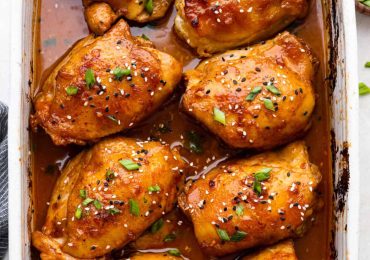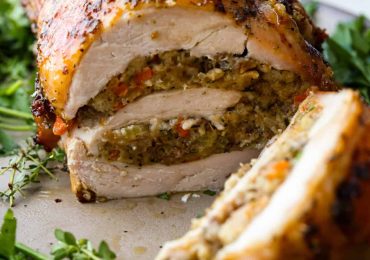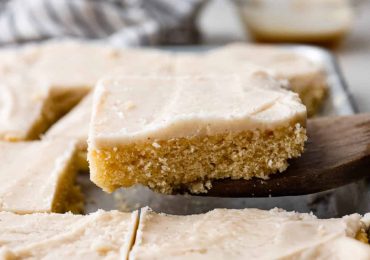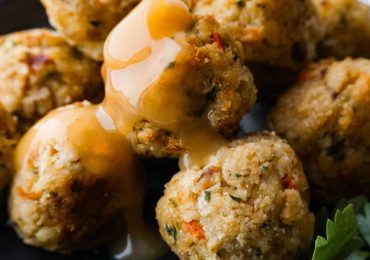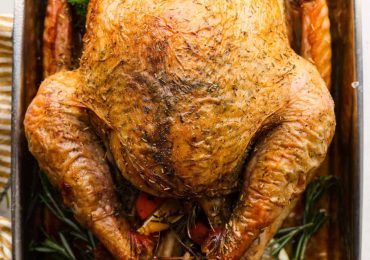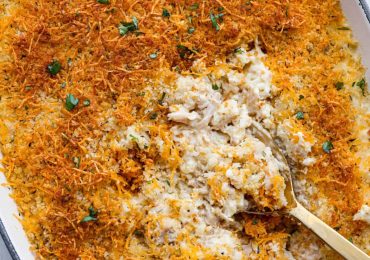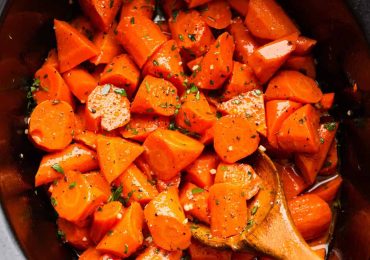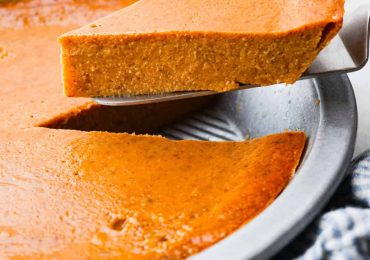This website may contain affiliate links and advertising so that we can provide recipes to you. Read my disclosure policy.
Look no further! This roasted turkey recipe is the absolute juiciest, fool-proof turkey recipe you will ever need. You’ll have the confidence to make a perfect turkey every time. This deliciously seasoned turkey will be the star of your Thanksgiving meal!
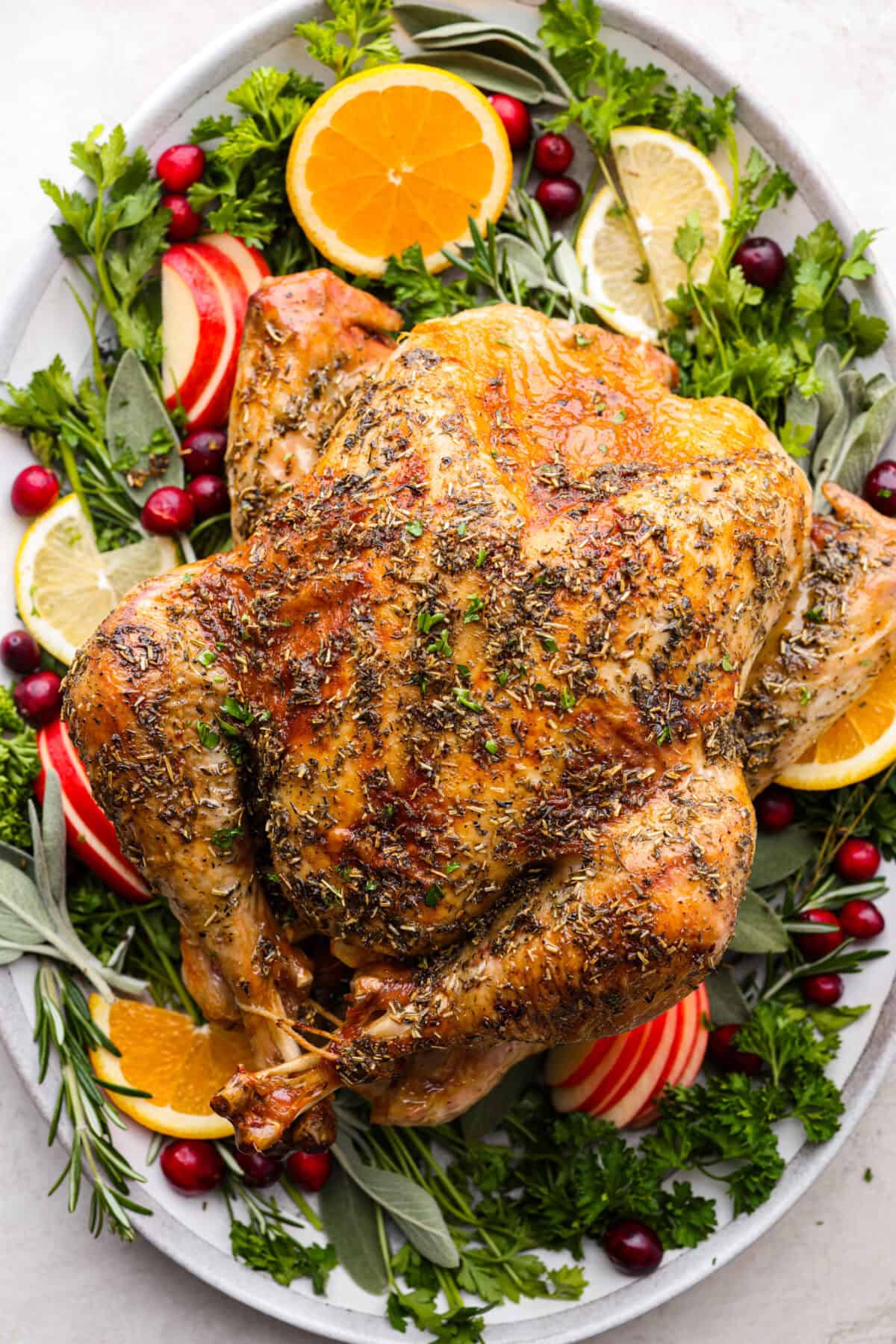
Turkey Timeline
I want you to be as prepared as possible for turkey day! My turkey timeline breaks it down into the days, hours, and minutes leading up to roasting time.
- 3-7 Days Before Cooking: Plan ahead to thaw the turkey! Place the frozen turkey in the refrigerator to thaw safely. Refrigerate your turkey for 24 hours for every 5 pounds. A 15-pound turkey will take about 3 days to thaw in the refrigerator. The thawing time also depends on the size of your turkey!
- 2 Days Before Cooking: Check the turkey to make sure it is thawing correctly!
- 4-5 Hours Before Serving: Watch the clock! Time the turkey to come out of the oven 30 minutes before serving. If you’re eating at 5:00 PM, make sure the turkey is prepped and in the oven by 12:30 PM.
- 30 Minutes Before Cooking: Remove the turkey from the refrigerator about 30 minutes before preparing your turkey for roasting.
You Asked, I Answered
I asked all of YOU what your biggest turkey struggles are and took all of your responses to heart when I wrote this recipe. The turkey is the star of the show and one thing that all of you asked for was, “How do I make my turkey juicy and not dried out?”
Roasting a turkey can be so intimidating, but I am here to help! I really want you to feel confident by the end of this post. Everyone will be raving about your perfect oven-roasted turkey. In fact, My son said it’s the best turkey he has EVER had and he can eat an entire turkey breast all by himself! This juicy turkey recipe is the absolute BEST!
Ingredients to Make a Juicy Roasted Turkey
I have tweaked and perfected the ingredients over the years, and these ingredients will help you achieve the most flavorful and juiciest, roasted turkey!
Turkey and Stuffing
- Turkey: 12 to 20 pounds, thawed.
- Onion: Delicious onion flavor absorbs into the turkey.
- Garlic: Fresh garlic cloves add the best aromatic flavor!
- Rosemary and Thyme sprigs: Bold fresh herbs add incredible flavor.
- Apple: I love using a sweet crisp apple cut into quarters.
- Lemon: Brightens the flavors! Use an orange for a delicious alternative.
Alyssa’s Pro Tip
Don’t cook traditional stuffing inside of your turkey! The turkey cooks at a different rate than the stuffing. It will result in an overcooked turkey and the stuffing may not be at a temperature that is safe to eat! Use onion, garlic, apple, lemon, and fresh herbs instead. This will add flavor and help retain moisture during the cooking process!
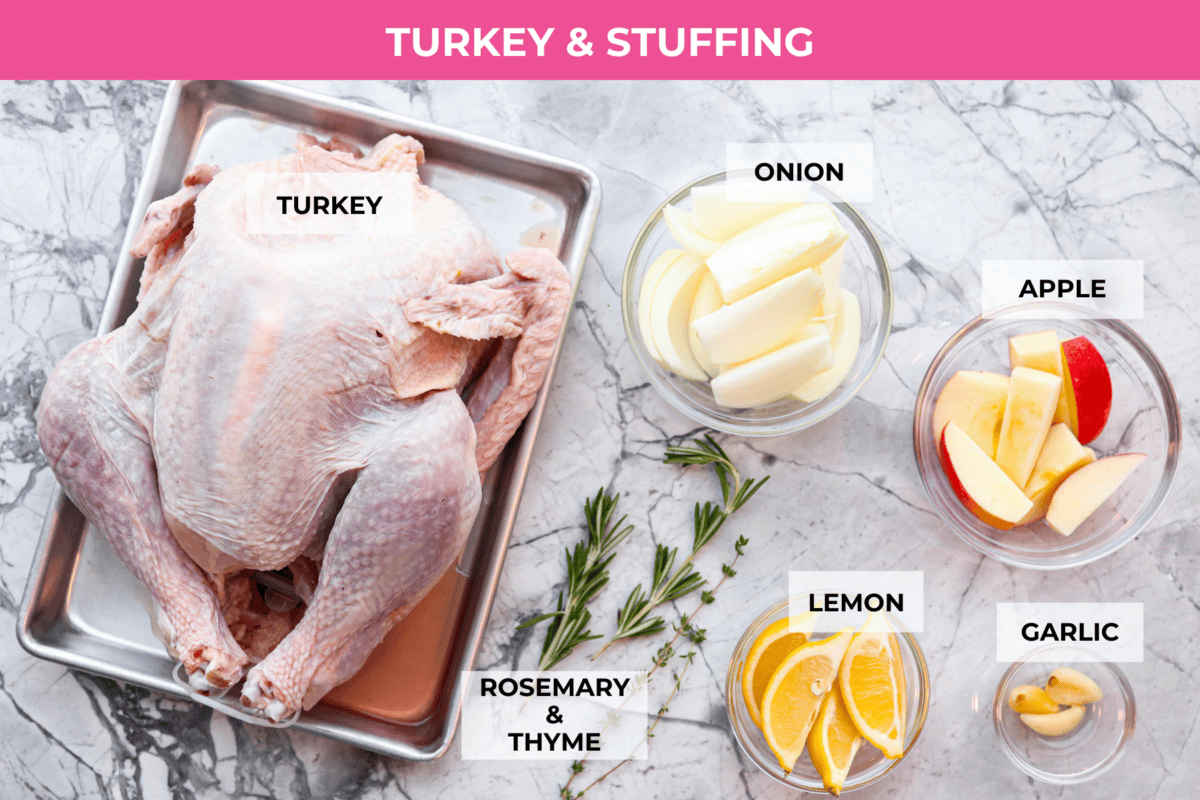
Herb Butter
- Butter: Makes the turkey meat tender and rich in flavor. It also gives the skin its crispy and golden color!
- Dried Herbs: Oregano, rosemary, sage, and thyme are the ultimate turkey seasonings! I prefer dried herbs because fresh herbs tend to burn on the top of the turkey. You’re welcome to use fresh!
- Salt and Pepper: Balances the flavors in the turkey!
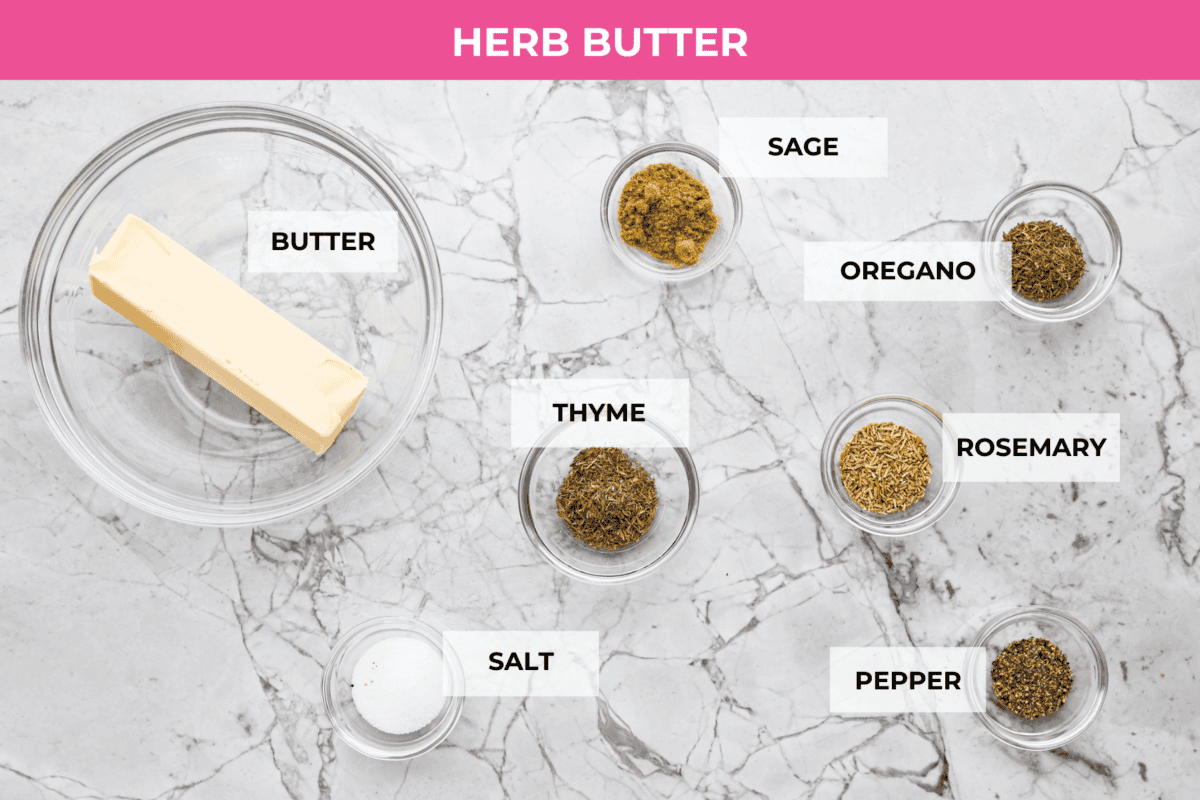
How to Thaw and Prep a Turkey
It is best to start with a completely thawed turkey. The rule of thumb is 24 hours for every 5 pounds of turkey. This can take 3-7 days, and I add an extra day just in case! If you need to speed up the process, thaw in cold water. You can check a turkey with a thermometer and it should read 32 degrees Fahrenheit throughout the bird. Anything colder and it might still be frozen. Remember to never thaw your turkey at room temperature! Once thawed, here are a few steps to prepare your turkey.
- Remove From Fridge: Remove your turkey from the refrigerator about 30 minutes prior to preparing. This will help it to bake more evenly! I place the turkey on a large baking sheet to catch any juices.
- Remove the Neck, Giblet Bag, and Plastic Cage: Remove the neck and giblet bag from the turkey cavity. Save them to make my incredible giblet gravy! Take off the plastic cage holding the legs together.
- Dry: Pat the turkey dry, soaking up any excess moisture with paper towels.
- Fold Under the Wings: Fold the wings under your bird. This will prevent them from burning and drying out.
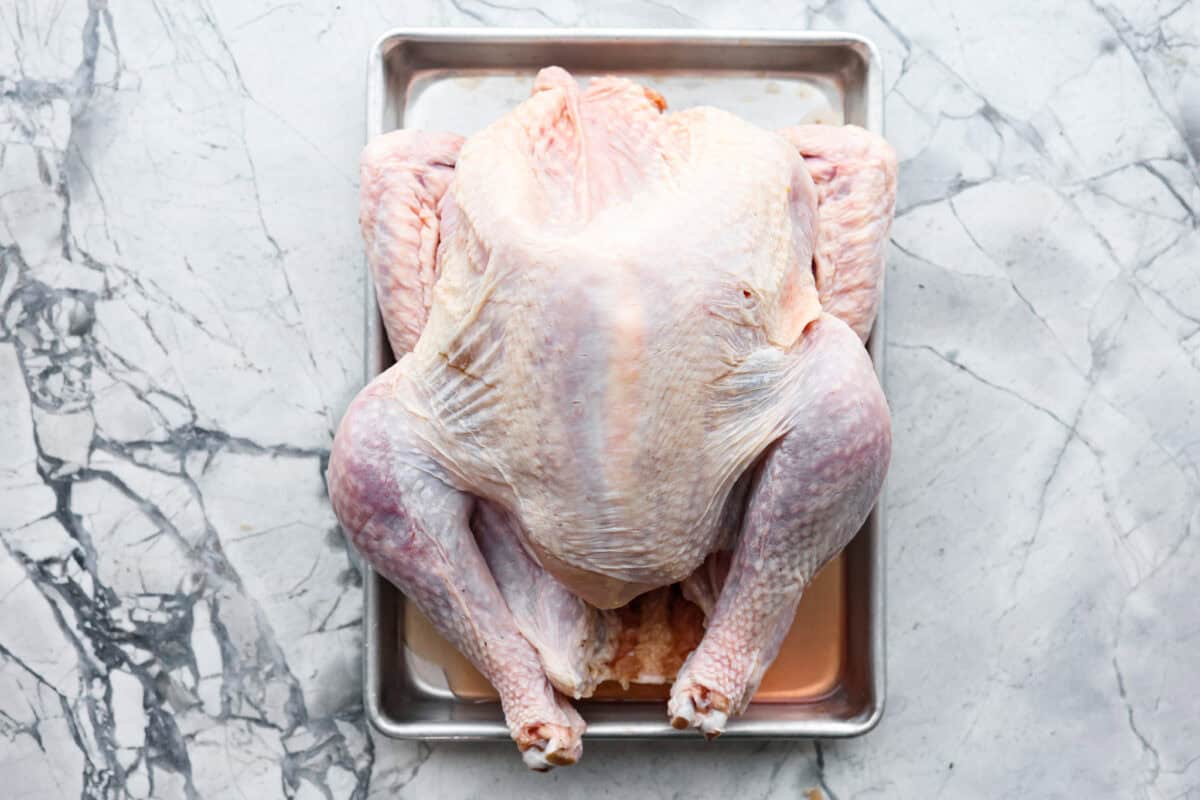
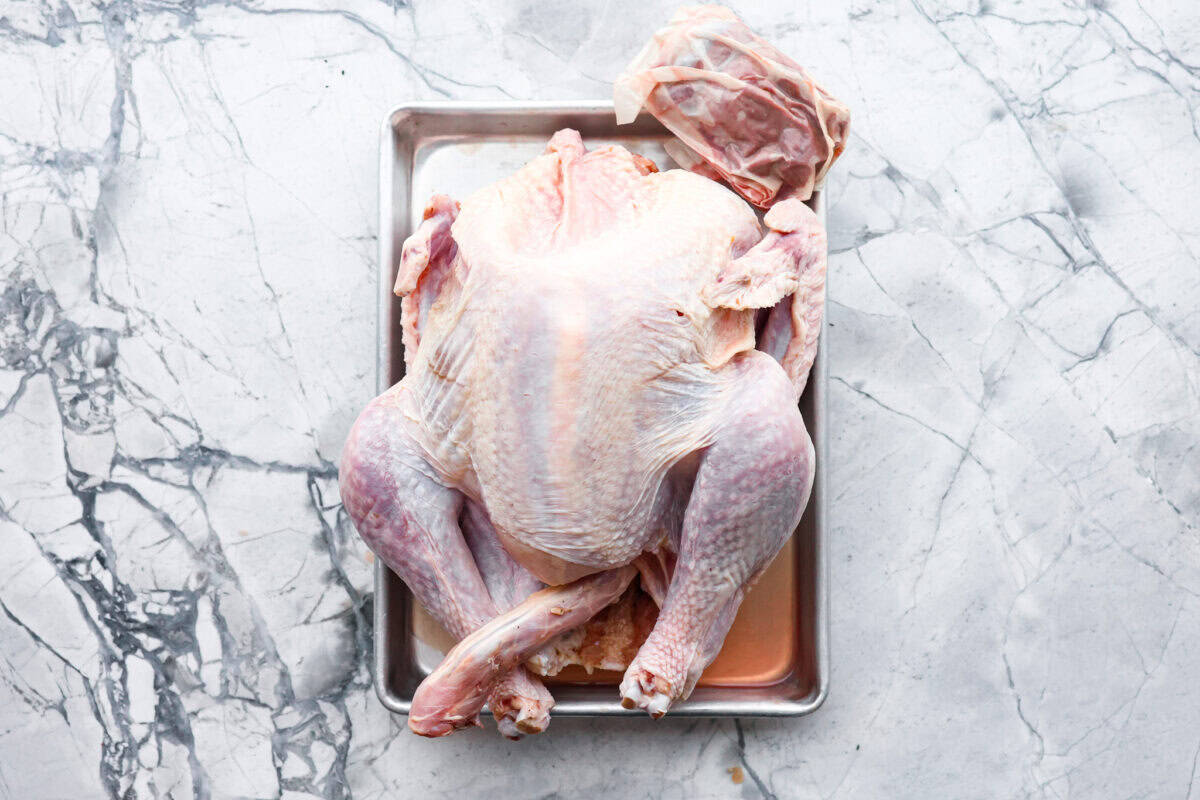
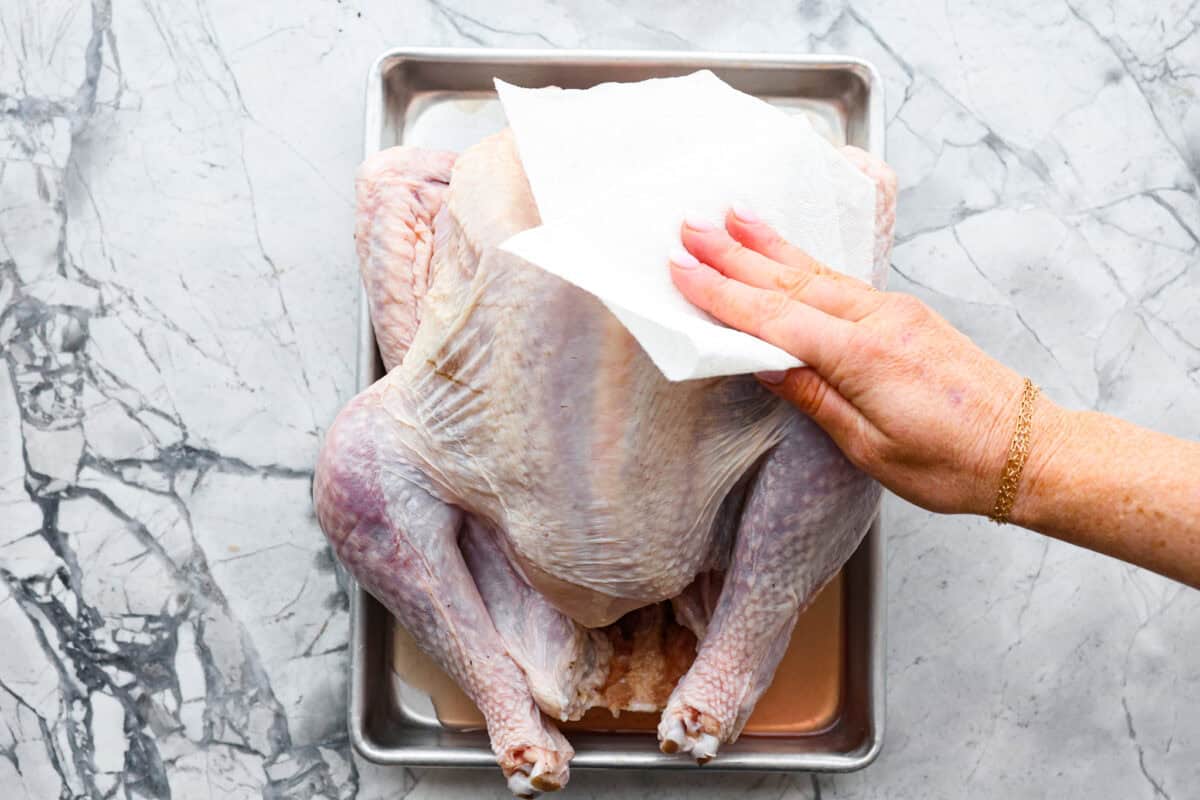
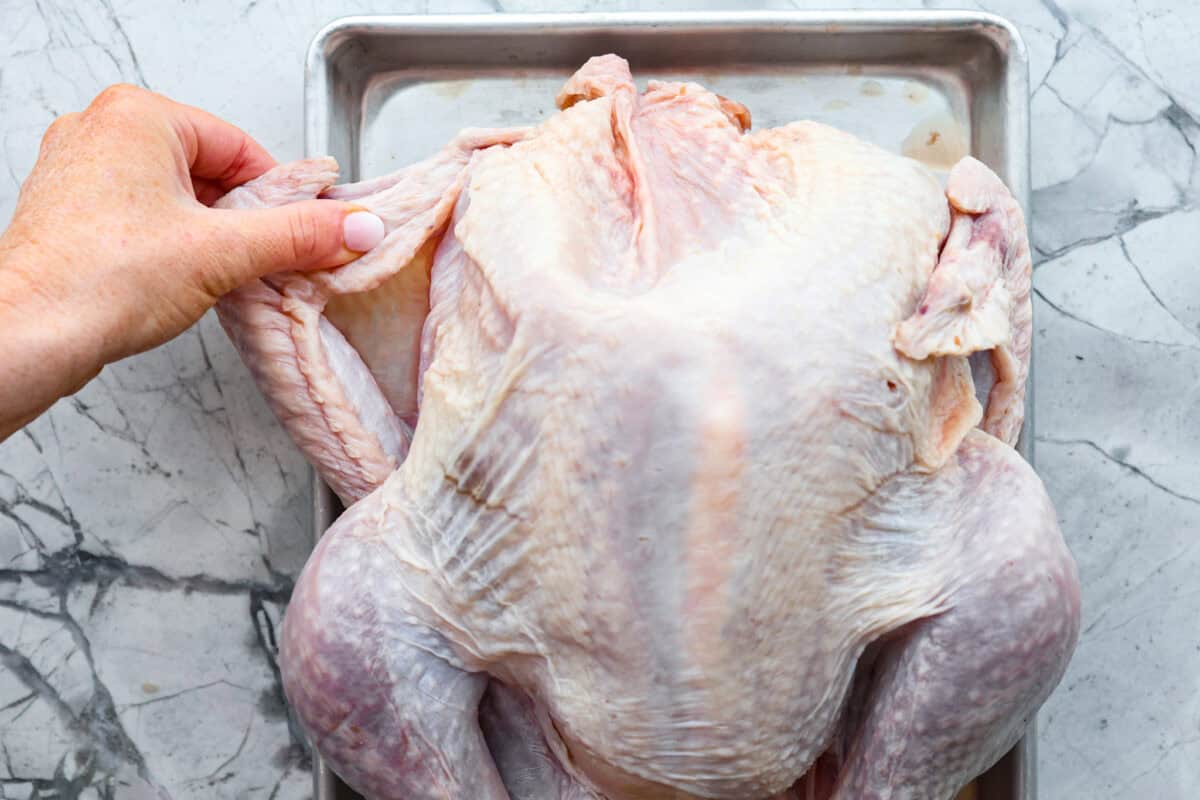
Roasting Instructions for a Juicy Turkey
This recipe is super straightforward and you will become a turkey master with my step-by-step instructions! No more stressing about the turkey on Thanksgiving day.
- Prepare and Stuff the Turkey: Preheat the oven to 325 degrees Fahrenheit. To prepare the turkey, remove the neck, giblets, and plastic cage holding the legs together. Pat the turkey dry using paper towels then tuck the wings under the turkey. Stuff the turkey with the onion, garlic, apple, lemon, rosemary, and thyme.
- Combine the Herb Butter Mixture: In a small bowl combine the butter, thyme, oregano, rosemary, sage, salt, and pepper.
- Cover With Herb Butter: Rub the herb butter evenly all over the turkey.
- Under the Skin: Loosen the skin and spread the herb butter underneath the skin. (This infuses the turkey breast with incredible flavor and allows the flavors to go deeper into the turkey. The butter helps to keep the meat juicy, and can also help prevent it from drying out. Don’t skip this part!)
- Tie the Legs: Tie the legs together using kitchen twine or string.
- Place in a Roasting Pan: Position the prepared bird in a large roasting pan breast side up.
- Insert Thermometer/ Roast Turkey: Remove the pop-up thermometer from the turkey. Insert an oven-safe thermometer into the thickest part of the breast, about 2 inches deep. Be careful not to hit the bone! Cook for 15 minutes for each pound or until the internal temperature reaches 165 degrees Fahrenheit and the juices run clear. Let the roasted turkey rest for 20 minutes before carving.
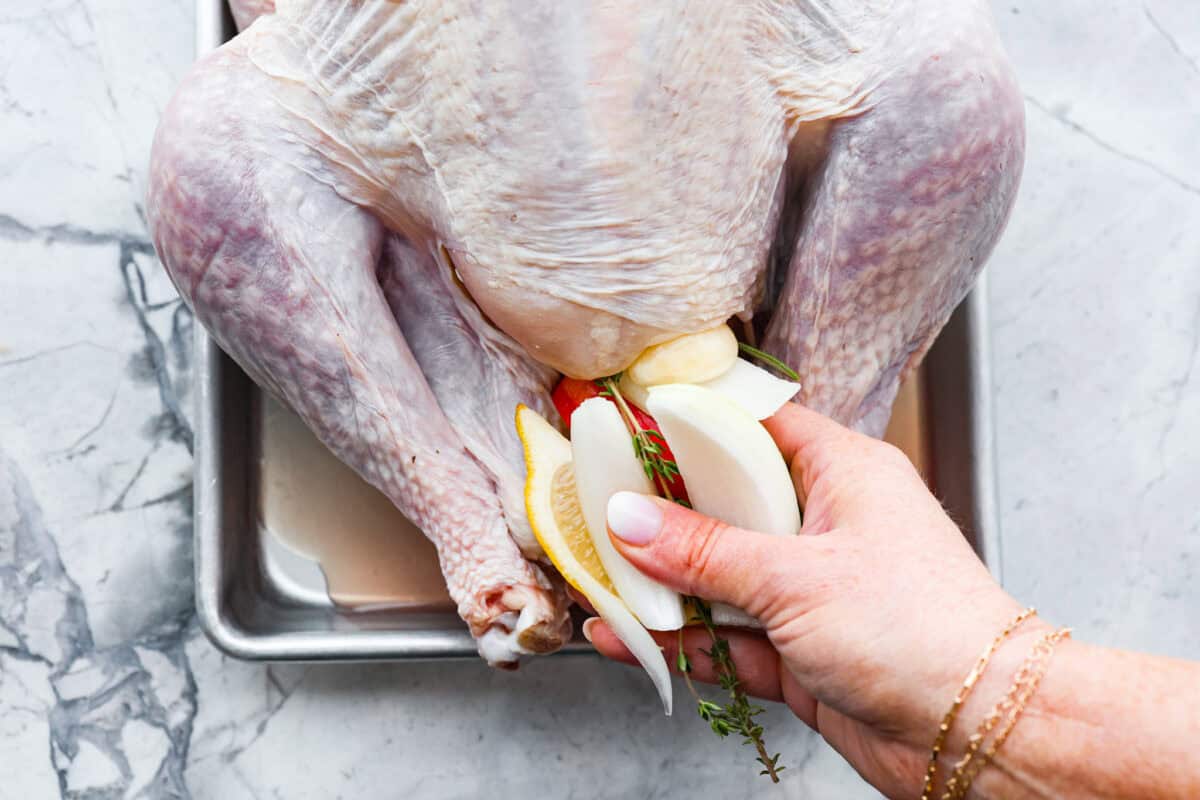
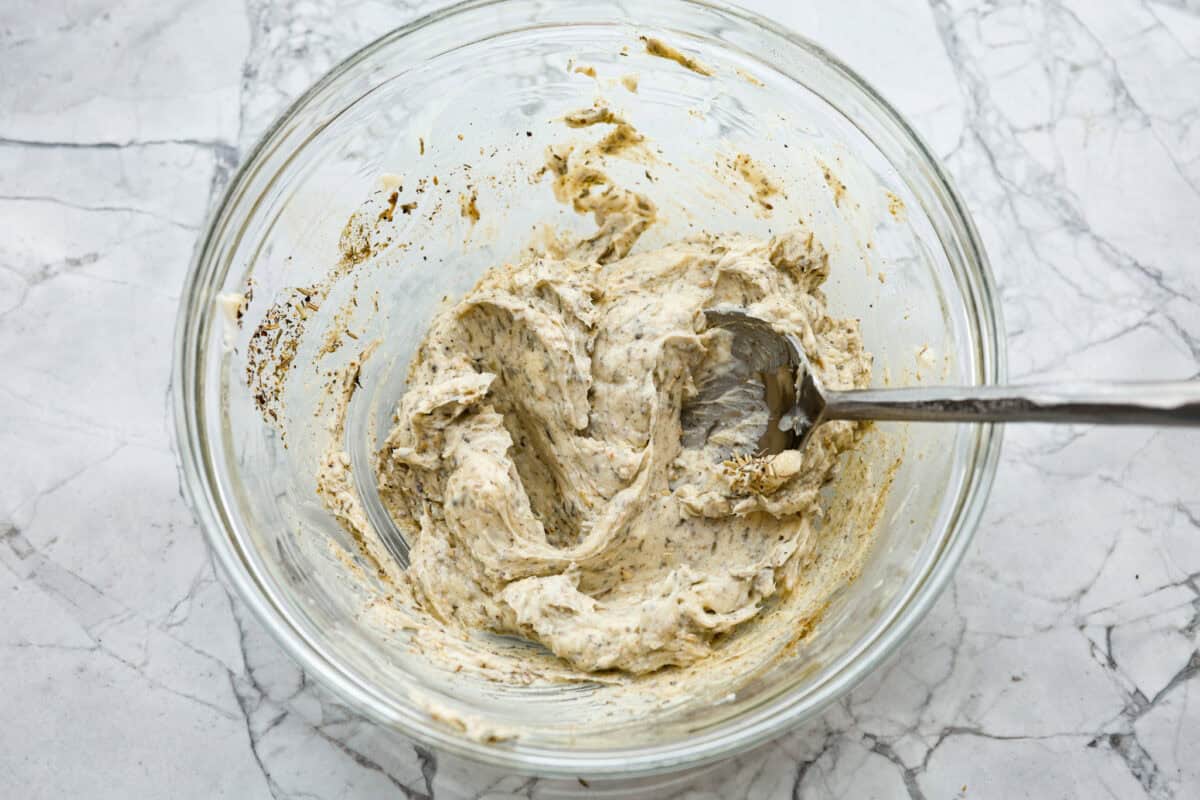
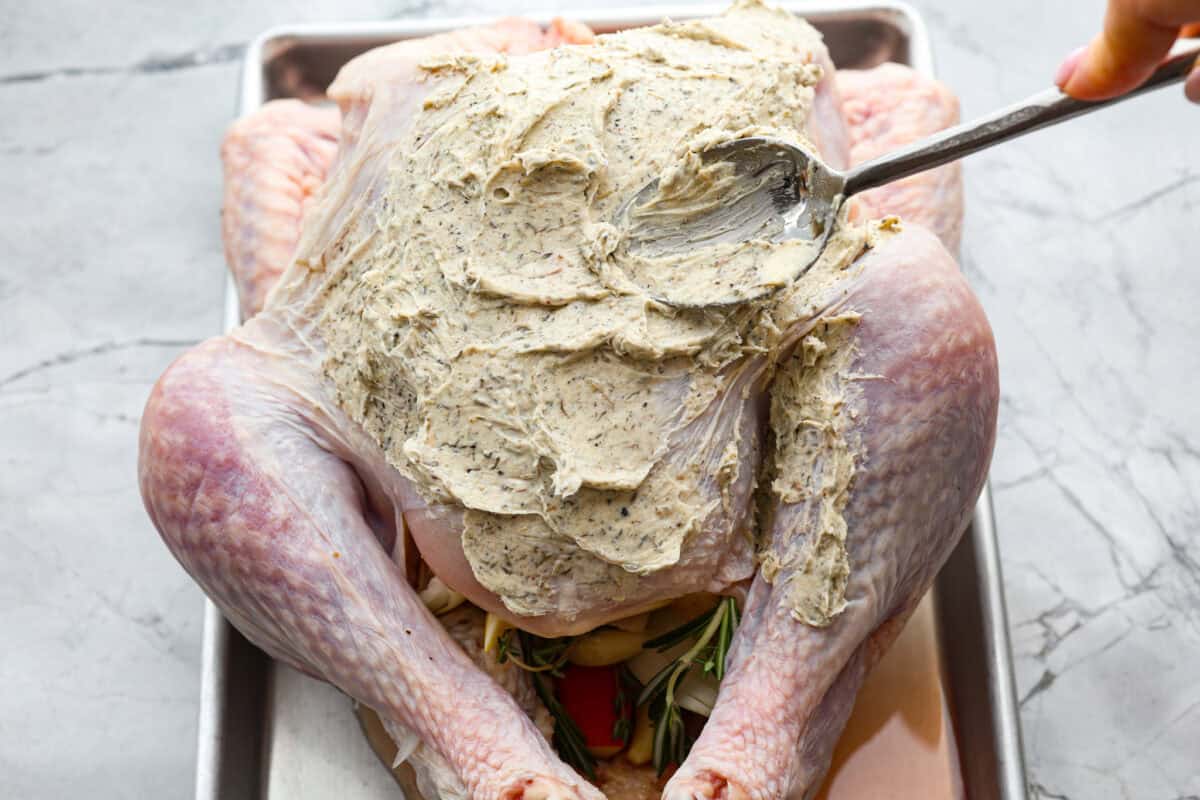
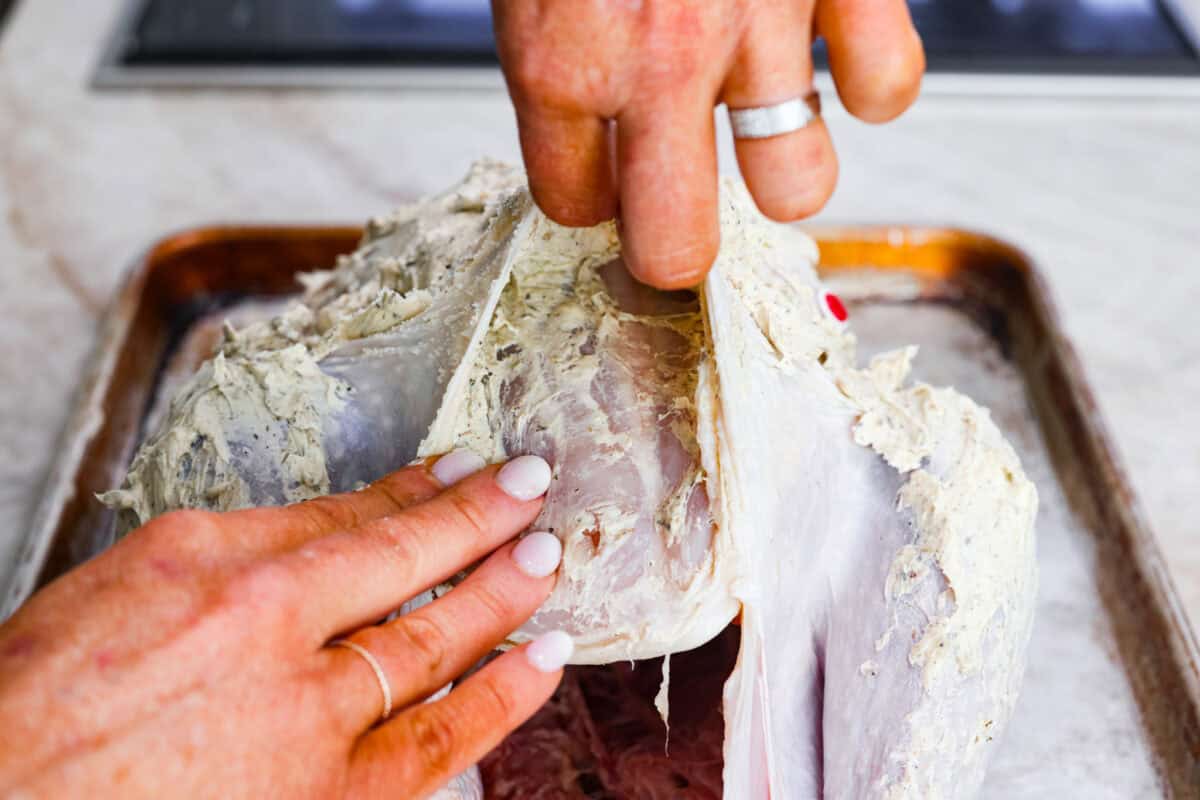
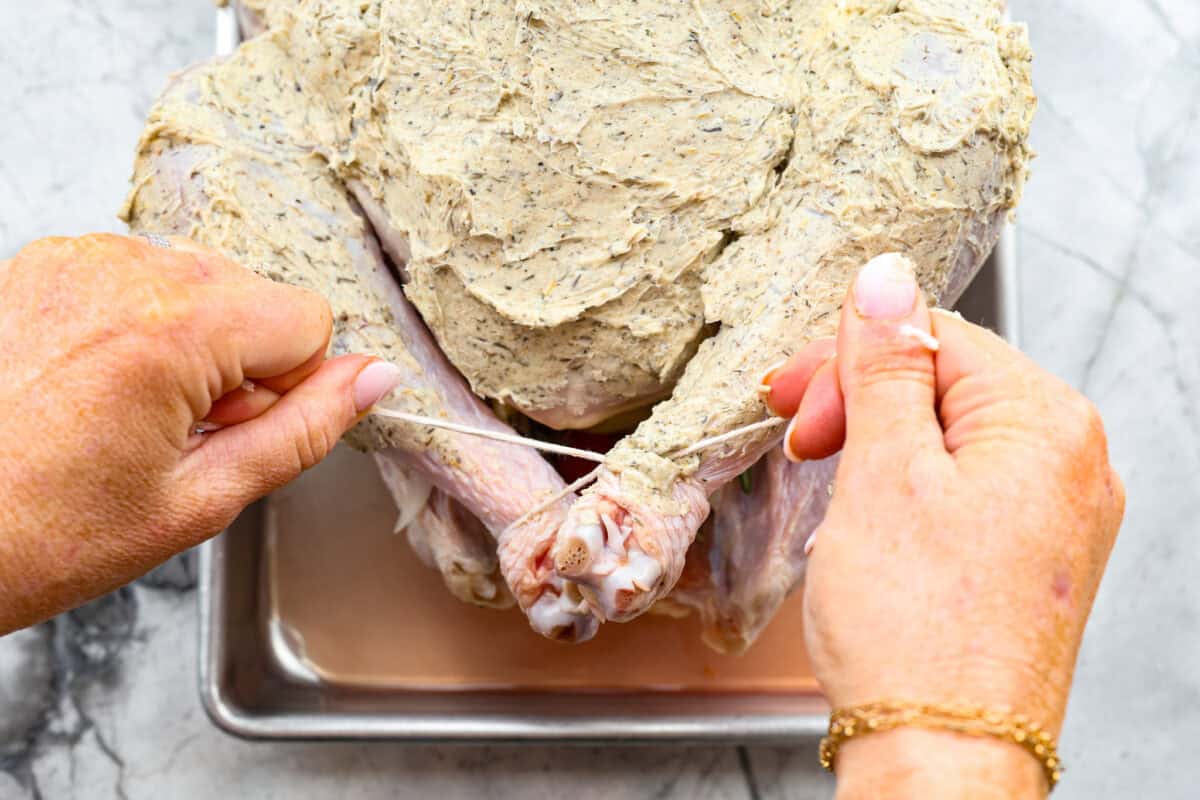
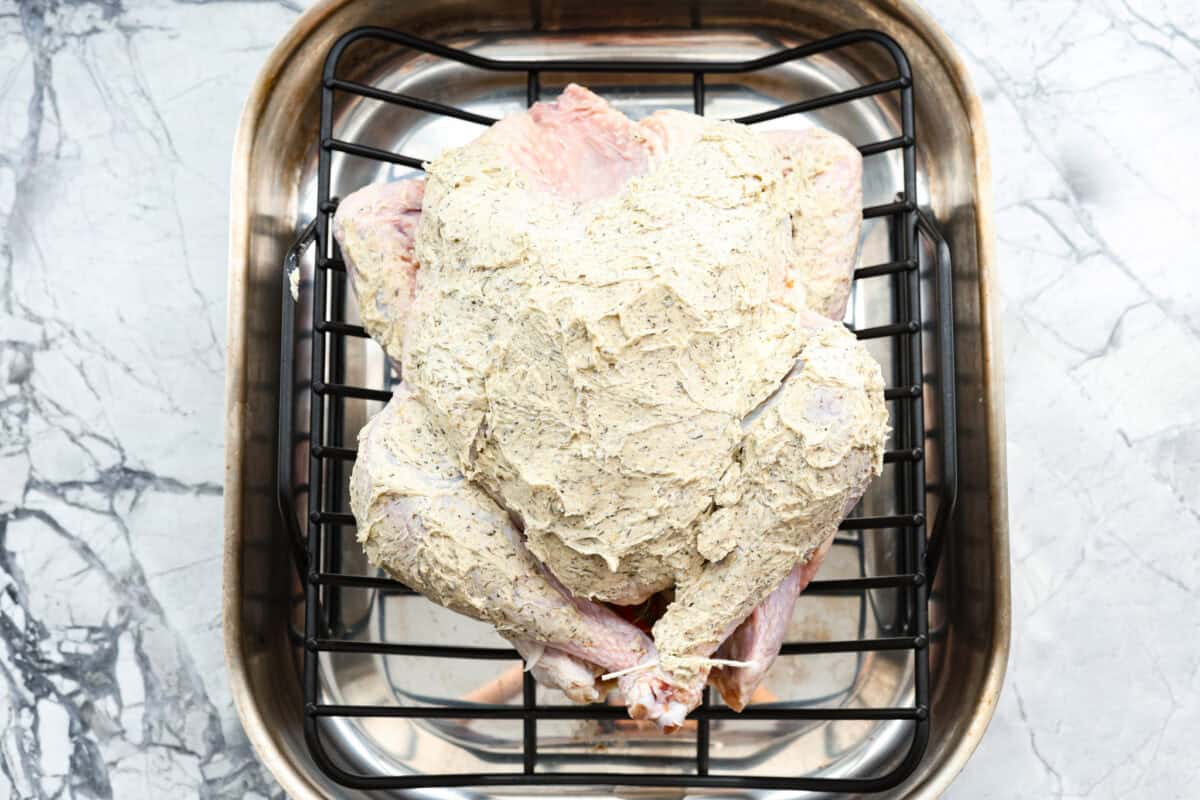
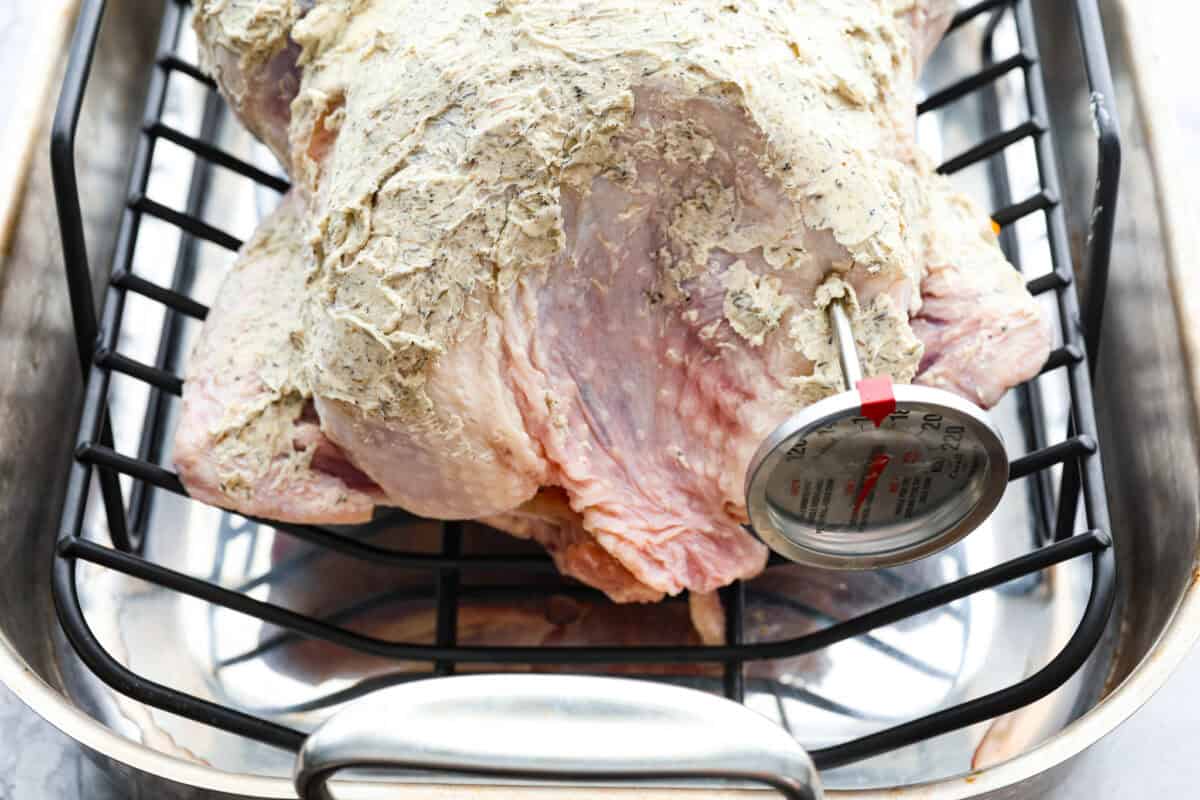
What if the Skin is Getting Too Dark?
If the skin on the top of your roasted turkey is getting too dark and crispy, here are some tips to help you out!
- Tent with Foil: This helps protect the turkey breast from direct heat, but continues to cook the rest of the turkey evenly. Cover the turkey loosely with the aluminum foil, then remove it towards the end, if needed.
- Check the Oven Temperature: The oven might be too hot for the turkey. I like to roast my turkey at 325 degrees Fahrenheit. If you need to reduce the oven temperature to slow the cooking process you can. A lower temperature also helps the turkey to cook more evenly.
- Rack Placement: Make sure the turkey isn’t too close to the top element of the oven. Adjust or remove one of the racks if needed to make room for the turkey to roast. Place the turkey in the lower half of the oven.
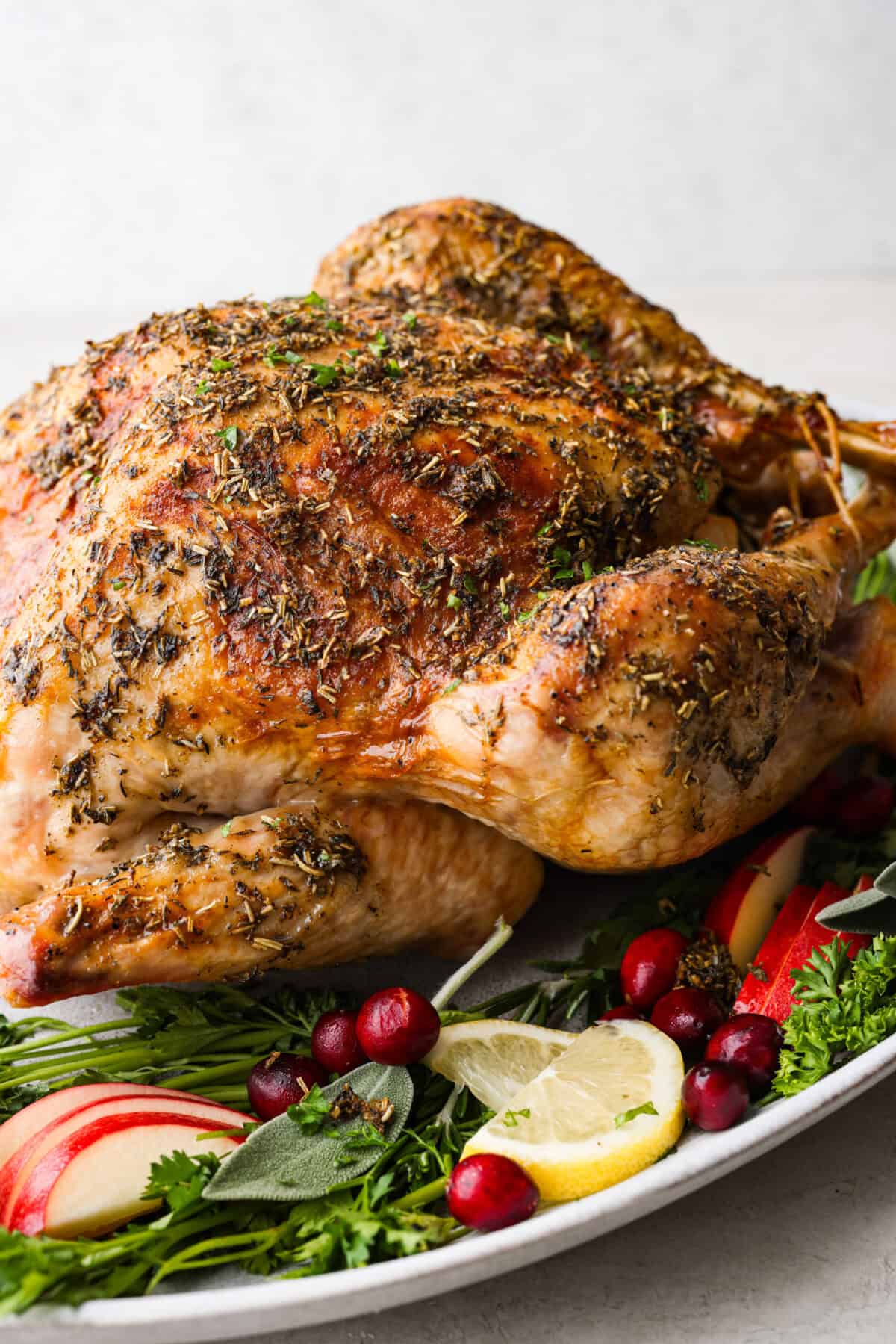
Why is My Roasted Turkey Too Dry?
The most common turkey struggle I hear about is having a dry turkey. Most of the time it’s because your roasted turkey has cooked for too long. You want to make sure the internal temperature of your turkey is 165 degrees Fahrenheit.
- DO NOT Use the Pop-Up Timer: Immediately discard it when preparing the turkey. The pop-up timer will usually roast the turkey to 180 degrees Fahreneheit before it pops. That is far past the correct cooking temperature. The best way to watch the temperature is to use a leave-in thermometer or an instant-read thermometer.
- Thermometer Placement: The best place to insert the thermometer is in the thickest part of the breast. Insert your thermometer about 2 inches into the breast being careful not to hit the bone.
- Brining: Brining the turkey is also a great way to help the turkey retain moisture during the process. I recently dry-brined a turkey and it turned out incredible. I also have a great method for a wet brine turkey. Be sure to brine your turkey 24-48 hours before cooking.
- Use Chicken Stock: Adding 1 to 2 cups of chicken stock to the bottom of the roasting pan will keep the turkey from drying out. It also helps when making your turkey gravy at the end. If you are planning to brine your turkey, then skip this tip.
How to Make Turkey Gravy?
This is one of my most asked questions! Making pan gravy is actually super easy! My Turkey Gravy is a simple recipe made with pan drippings, flour, and chicken broth. You just whisk it together over the stove and it comes together quickly! The flavors of the turkey make an incredible gravy. Salt and pepper to taste then pour it into your gravy boat!
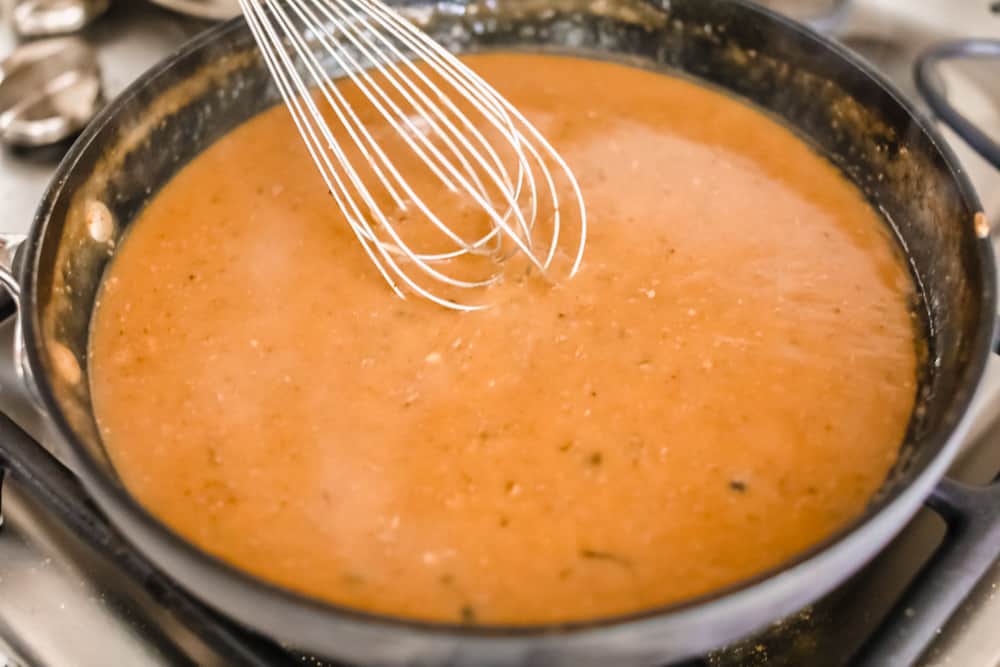
How to Carve a Roasted Turkey
Follow my carving tips to get the most out of your bird! I walk you through every step so that you can beautifully serve your turkey to your guests.
- Let it rest! This is an important step to ensure the turkey remains moist, juicy, and full of that amazing flavor. Letting the turkey rest also helps the moisture redistribute throughout the meat and retain the tenderness. Let the turkey rest for about 20-30 minutes, and then it is ready to carve!
- Use a Sharp Knife: The most important thing when carving your turkey is to use a sharp knife. I like to use a chef’s knife or a serrated knife.
- Legs and Thighs: I like to start with the legs (drumsticks) and thighs. Start cutting through the joint. Sometimes you have to twist to help loosen the joints. This helps me separate the leg better from the turkey. Once you cut the leg from the turkey, you can find the joint between the two and separate the leg from the thigh.
- Breast: Slice close to the rib cage and remove the breast on each side. Once you have removed the whole breast, begin slicing even pieces against the grain. Repeat with the other breast.
- Wings: Slice through the joint of the wing. Apply some pressure if needed and slightly twist the wing to help loosen the joint.
- Excess Meat: Remove any excess meat left on the carcass then discard the carcass. Don’t forget to save the wishbone if you like that tradition like we do!
- Plate: Plate everything together on a big beautiful serving platter.
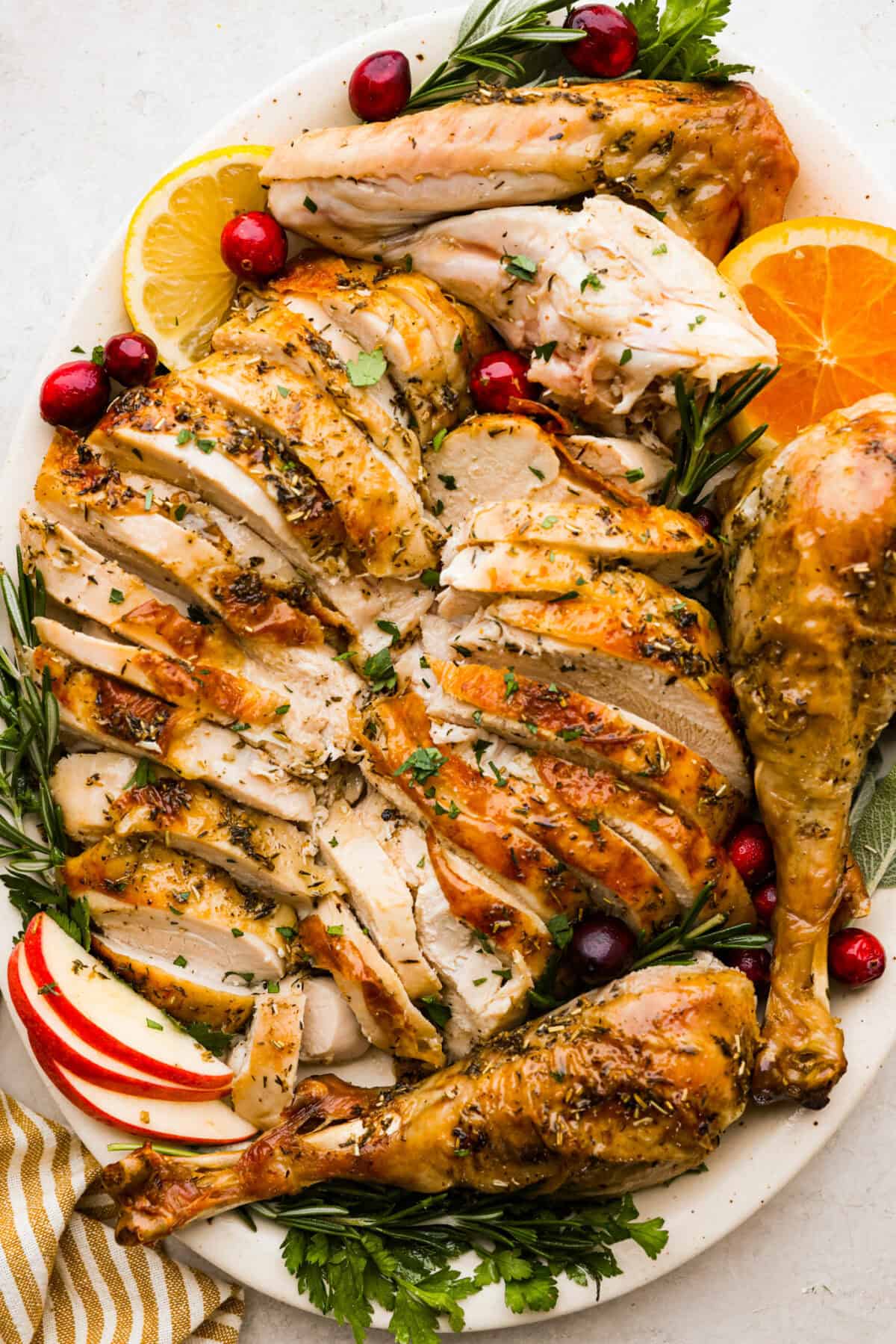
How to Store Leftover Roasted Turkey
This roasted turkey recipe makes the BEST leftovers! I love to make Leftover Turkey Casserole or Turkey Noodle Soup to use up the rest of my Thanksgiving dinner.
- In the Refrigerator: Once the roasted turkey has cooled, place it in an airtight container and refrigerate for 3 to 5 days.
- In the Freezer: After your turkey has cooled down, place it in a freezer bag. Lay your turkey flat in the bag and then zip or suction out all the air. Label your bag with the date, and store it for up to 1 month in the freezer. When ready to reheat, place in the refrigerator overnight to thaw.
- To Reheat: To reheat in the oven, place in a baking dish at 350 degrees Fahrenheit for 12 to 15 minutes or until warm. When reheating in a microwave, heat for 1 to 2 minutes until warm. Try not to overheat, as this will leave your leftover turkey dry and hard.
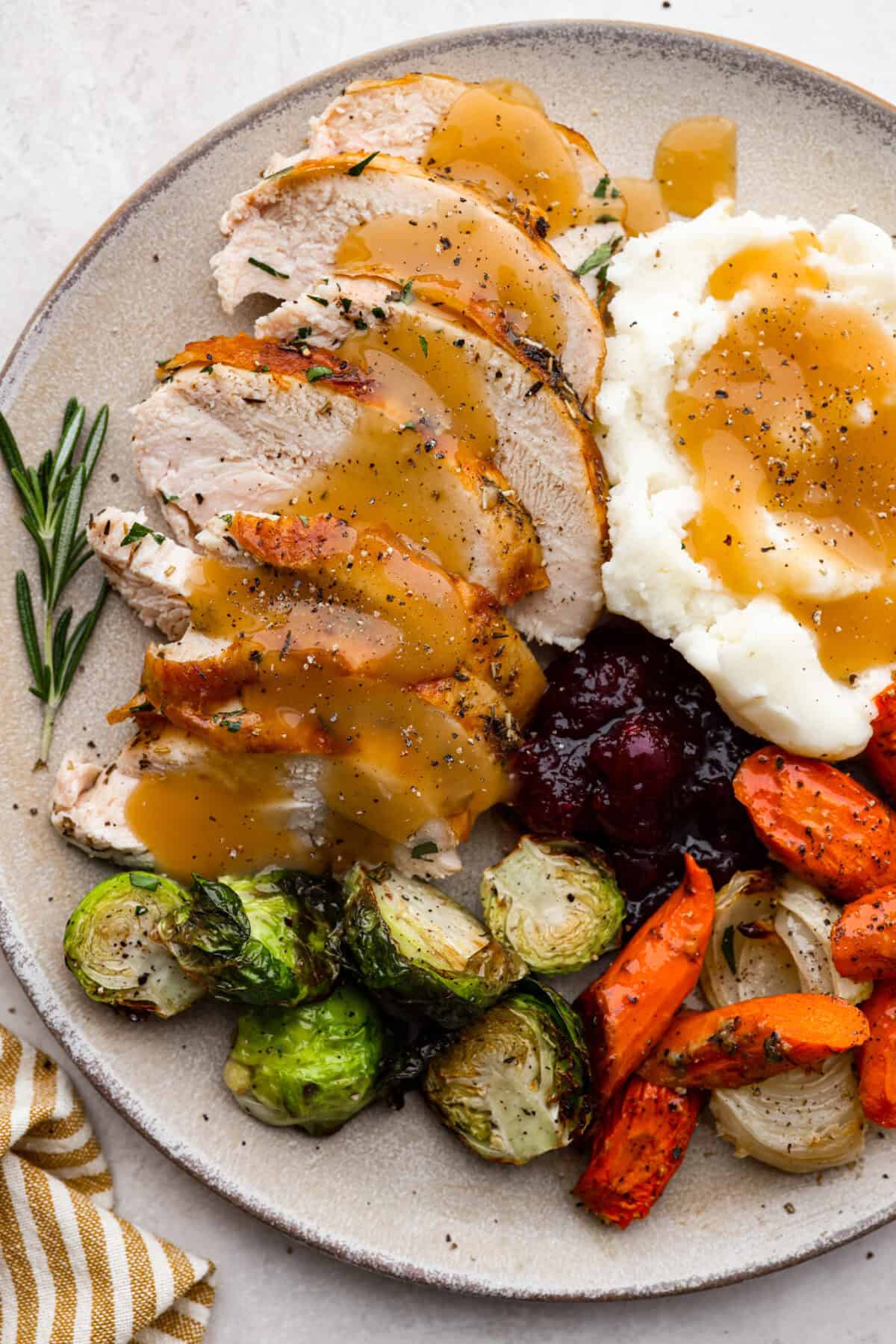
Tried and True Thanksgiving Side Dishes
Pin this now to find it later
Pin It
Herb Butter
-
Thaw the turkey 3-7 days in advance in the refrigerator! Follow my thawing tips in the post.
-
Preheat the oven to 325 degrees Fahrenheit. To prepare the turkey, remove the neck, giblets, and plastic cage. Pat the turkey dry using paper towels then tuck the wings underneath the turkey.
-
Stuff the turkey with the onion, garlic, apple, lemon, rosemary, and thyme.
-
In a small bowl combine the butter, thyme, oregano, rosemary, sage, salt, and pepper.
-
Rub the herb butter evenly all over the turkey.
-
Loosen the skin and spread the herb butter underneath the skin.
-
Tie the legs together using kitchen twine or string.
-
Position the prepared bird in a large roasting pan breast side up.
-
Remove the pop-up thermometer and insert an oven-safe thermometer into the thickest part of the breast, about 2 inches deep. Be careful not to hit the bone!
-
Cook for 15 minutes for each pound or until the internal temperature reaches 165 degrees Fahrenheit and the juices run clear. Let the turkey rest for 20 minutes before carving.
Originally Posted on October 20, 2019
Calories: 68kcalCarbohydrates: 4gProtein: 0.3gFat: 6gSaturated Fat: 4gPolyunsaturated Fat: 0.3gMonounsaturated Fat: 2gTrans Fat: 0.2gCholesterol: 16mgSodium: 205mgPotassium: 42mgFiber: 1gSugar: 2gVitamin A: 234IUVitamin C: 5mgCalcium: 21mgIron: 1mg
Nutrition information is automatically calculated, so should only be used as an approximation.

